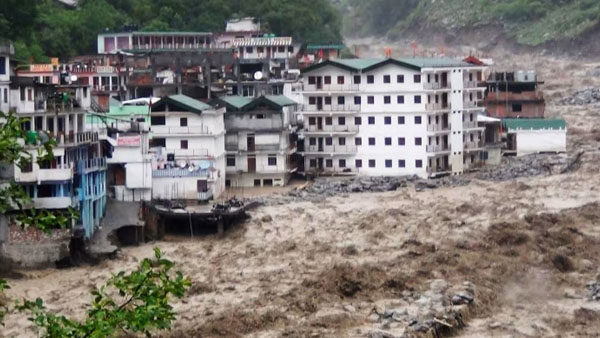By Satyabrat Borah
The rain came down in a fury as if the heavens had decided to empty themselves in one violent burst. Kishtwar nestled in the rugged embrace of Jammu and Kashmir’s mountains bore the brunt of a cloudburst that turned streams into torrents and hillsides into cascading mud. Barely ten days earlier Dharali in Uttarakhand had faced a similar fate: flash floods that swept away homes, roads and hopes. These are no longer isolated incidents, no longer the freak events we once called them. Cloudbursts, those sudden intense downpours that drench a small area in minutes, have become the new normal, a grim signature of a planet pushed to its limits by climate change. Yet as the waters recede and the rescue teams scour the debris a harder truth emerges: the devastation is not just the work of nature’s wrath but also of human folly, unplanned development, reckless construction and a collective refusal to heed the warnings of a warming world.
In the Himalayas where the earth’s youngest mountains stand tall and fragile, the interplay of climate change and human interference is a recipe for disaster. Cloudbursts have become more frequent and ferocious. Scientists point to a warming atmosphere capable of holding more moisture as a key driver. The Indian Meteorological Departments data shows an uptick in extreme weather events across the Himalayan region over the past decade. Warmer air fuels heavier precipitation and when it falls on slopes already destabilized by construction the results are catastrophic. In Kishtwar as in Dharali the floods did not just carry water they carried away bridges, livestock and livelihoods. The mountains scarred by roads carved without regard for their geology gave way in landslides that buried homes under rubble.
The hydrological system too is out of balance. Glaciers and the lifelines of rivers like the Ganga and Indus are melting at an alarming rate. Studies estimate that Himalayan glaciers could lose a third of their volume by 2100 if global warming continues unchecked. This isn’t just a future threat, it’s happening now. Meltwater feeds swollen rivers but it also triggers glacial lake outburst floods and sudden bursts of water from glacial lakes that can wipe out entire villages downstream. Meanwhile aquifers and the underground reservoirs that sustain communities during dry spells are depleting faster than they can recharge. Deforestation and concretization have sealed the earth preventing rainwater from seeping into the ground. In places like Uttarakhand and Himachal Pradesh where tourism and hydropower projects drive relentless construction the mountains are being hollowed out and their ecosystems stretched to breaking point.
But the story of climate change isn’t confined to the Himalayas. Across the globe the planet is reeling under the weight of human excess. In Portugal this June temperatures soared past 46 degrees Celsius, a record that left fields parched and communities gasping. Europe, often seen as a bastion of temperate weather, has been scorched by heatwaves that claimed nearly 2000 lives this year alone. Across the Atlantic wildfires in the United States have raged beyond their traditional August September season consuming over 1000 acres of land since January and displacing thousands. These are not mere anomalies, they are the consequences of a world where carbon emissions continue to climb where forests are felled for profit and where the pursuit of growth overrides the need for survival.
Back in India the Himalayan states are a microcosm of this global crisis but they also highlight a uniquely local failure. Unplanned development has turned vulnerable landscapes into ticking time bombs. In the race to build roads, hotels and dams to cater to tourists and generate power, environmental impact assessments are often treated as mere formalities. Hillsides are blasted rivers diverted and forests cleared with little regard for the delicate balance that holds these ecosystems together. The Char Dham highway project in Uttarakhand for instance has been flagged by geologists for increasing landslide risks yet it barrels ahead. Hydropower projects touted as green energy have destabilized river valleys making them more susceptible to floods. When a cloudburst hits the loose soil and weakened slopes give way, amplifying the destruction.
The irony is that the communities bearing the brunt of these disasters are often the least responsible for them. The people of Kishtwar and Dharali are not the ones making high stakes decisions in corporate boardrooms or government offices. They are farmers, shopkeepers and daily wage workers whose lives are upended when the rains come. Their homes built on floodplains because of limited land are the first to be swept away. Their fields dependent on predictable monsoons are either drowned or left barren. For them climate change is not an abstract concept discussed at global summits, it is the mud in their homes, the missing livestock, the loved ones lost in the deluge.
Yet the response to these crises remains maddeningly inadequate. Governments issue relief packages and promises of reconstruction but prevention is rarely on the table. The global discourse on climate change is mired in platitudes, carbon trading schemes, sustainability reports and net zero pledges that often amount to little more than greenwashing. In corporate boardrooms the focus is on optics not action. Meanwhile emissions continue to rise with India’s own carbon footprint growing as it balances development with environmental concerns. The Global Carbon Project notes that global CO2 emissions reached 36.8 billion tonnes in 2024 with no sign of peaking. Coal, the dirtiest fossil fuel, still powers much of India’s energy grid despite commitments to renewable energy.
The inaction is not just a failure of policy but of imagination. We continue to build as if the earth’s resources are infinite as if mountains can be tamed with concrete and steel. In the Himalayas every new road or dam is a gamble with nature yet the stakes are rarely acknowledged. Urban planners and policymakers ignore the warnings of geologists and environmentalists who have long cautioned against building in ecologically sensitive zones. The National Disaster Management Authority’s own guidelines stress the need for sustainable development in mountainous areas yet enforcement is weak. Local communities who often have traditional knowledge about living in harmony with their environment are rarely consulted. The result is a cycle of destruction Dharali yesterday Kishtwar today and another tragedy waiting in the wings.
Breaking this cycle requires a radical shift. First we must rethink development in the Himalayas. Construction projects need stricter oversight with mandatory environmental audits that are not just paperwork but genuine assessments of long term impact. Roads and buildings must be designed to withstand extreme weather, not exacerbate it. Reforestation and watershed management can help restore the natural barriers that protect against floods and landslides. Second, we need to invest in early warning systems. Satellite monitoring and real time weather data can give communities precious hours to evacuate before a cloudburst or glacial lake outburst flood strikes. Third and most critically we must address the root cause of climate change. This means not just reducing emissions but also adapting to a world that is already warmer and wetter. India’s renewable energy push is a step in the right direction but it must be scaled up with urgency backed by policies that phase out coal and incentivize clean energy.
On a global scale the fight against climate change demands accountability. Wealthier nations which have historically contributed the most to emissions must lead by example not just with funding but with concrete reductions. Developing nations like India caught between growth and sustainability need support technological, financial and intellectual to transition without sacrificing their aspirations. But above all we need a cultural shift, a collective awakening to the fact that the earth is not a resource to be exploited but a system we are part of. The search and rescue operations in Kishtwar and Dharali are a sobering reminder of what’s at stake. If we continue to lurch from one crisis to another the Himalayas and the world will pay a price too heavy to bear. The rains will keep coming fiercer and more unforgiving unless we learn to listen to the mountains and the skies.




